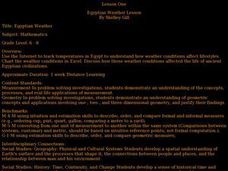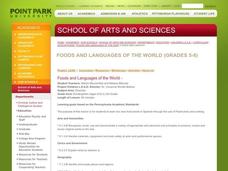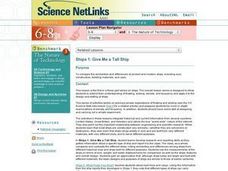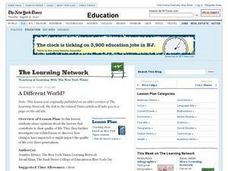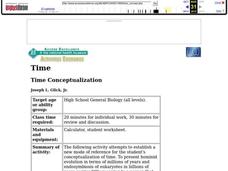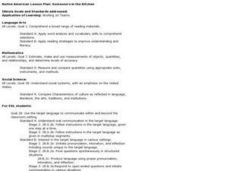Curated OER
Egyptian Weather Lesson
Learners chart temperatures in Egypt on spreadsheet to determine how weather conditions affect lifestyles.
Curated OER
Olympic Line Graphs
Sixth graders examine how to make line graphs. In this Olympic line graph lesson students make line graphs and search the given Internet sites to find data on their summer Olympic Game.
Curated OER
Foods and Languages of the World
Students review Mexico's location and language and learn to pronouns 10 new Spanish food words. Students listen as the book, Corn is Maize is read, touching and passing around an ear of Indian corn. Students discuss the contribution of...
Curated OER
Give Me a Tall Ship
Sixth graders develop an understanding of floating, sinking, density, and buoyancy and apply it to the design of testing of ships.
Curated OER
'Cross the Wide Missouri
Students perform a song, identify melodies, and discuss the history of folk songs.
Curated OER
Author's Influence Project
Eleventh graders use technology as a tool to research authors of literature being studied. Then students use a presentation program to make final presentations. This lesson allows them to create an understanding of the context related to...
Curated OER
Identifying Verb Tenses
How many different verb tenses are there? When do you use each? After introducing the different tenses with your upper elementary schoolers, have them read through a series of sentences, underline the verb in each sentence, and then...
Curated OER
Westward Ho!
Second graders use a minimum of three maps of Kansas developed during the 1800's. They plot five major settlements that developed near water sources. Students brainstorm reason settlements may have developed near water sources.
Curated OER
History of the American West
Ninth graders research early mining in California. They study the "placer method" for mining gold, which is surface mining that does not involve tunneling. They examine what it was like for the early miners to pan for gold with...
Curated OER
A Tall Story
Students investigate the growth rate of a man named Bob Wadlow. In this growth rate of a man lesson, students determine if the growth rate of this particular man was normal or abnormal. Students bring in data of their height over time...
Curated OER
Schoolhouses
Fifth graders research life in a one- room schoolhouse. They plan and carry out a mock day in a one-room schoolhouse. They make slates on a prior day by painting small boards with chalkboard paint.
Curated OER
Technology Blackout Day
Students describe the impact of modern technology inventions on daily life. They create a graph of the class's favorite item of technology and draw a picture of their favorite piece of modern technology.
Curated OER
Rockin? Chalk (Integrating science - make own chalk)
Students use plaster of Paris, talc, and cornstarch to create their own chalk. They hypothesize what mixture of ingredients produce the "best" chalk. Students discuss what they think are the characteristics of the "best" chalk.
Curated OER
The Perfect City
Learners analyze group influences on people, events and culture. They design their own perfect society and report it to the class.
Curated OER
Life Prior to Kristallnacht (1933-1938)
Students research the way of life of the Jews before Kristallnacht. Using new vocabulary and resources, they discover how carefree life was before the days of discrimination and antisemitism. In groups, they create a timeline of the...
Curated OER
Galileo: His Times & Beliefs
Students study Galileo and his scientific discoveries. They complete a series of experiments/model constructions, using 17th century equipment and procedures, to "recreate," demonstrate and explore the various discoveries of Galileo.
Curated OER
A Different World?
Students share their opinions in a brainstorming session on the factors that contribute to their quality of life. They read the article "Life Is Better; It Isn't Better. Which Is It?," from the NY Times and discuss the article as a...
Curated OER
Time Conceptualization
High schoolers use this activity to establish a new mode of reference to the conceptualization of time. To present hominid evolution in terms of millions of years and endosymbiosis of eukaryotes in billions of years carries little...
Curated OER
Rockin' Chalk
Fourth graders access prior knowledge of rocks and minerals. In this petroglyphs lesson, 4th graders become familiar with artwork on rocks. Students create original artworks using rock art.
Curated OER
From Molecules to Mole Day Do's
Students recognize methods used to define the mole. After converting various quantities to the mole, students provide a context for understanding the usefulness of scientific notation and the mole.
Curated OER
Betrayal of Penn's Promise - The Walking Purchase
Pupils role-play the 1737 Walking Purchase. In this Pennsylvania history lesson, middle schoolers role-play the 1737 Walking Purchase and analyze its effects. Pupils also consider how it would affect their community today.
Curated OER
Native American Lesson Plan: Someone's in the Kitchen
Students use vocabulary necessary to complete cooking activities and tell others about the food. They discuss similarities and differences between Native American and other nationalities' foods made in their families.
Curated OER
Babylonian Mathematics 2
Students research Babylonian mathematics. They calculate simple surd numbers. Students find the fractional form of rational numbers expressed as decimals. They work with numbers in base 60.
Curated OER
Waddle You Know About Penguins
Second graders study the similarities and differences of the seventeen species of penguins. They investigate habitats and how these habitats are suited to each species characteristics. They see how animals adapt to their environments.


